When it comes to finding the perfect workout earbuds, I always consider sound quality, comfort, and durability. Today, I dive deep into two popular options: the Sennheiser Momentum Sport and the new Beyerdynamic Verio 200. Both models cater to fitness enthusiasts who crave high-quality audio while exercising. I’ll explore various aspects, including what’s in the box, design, sound performance, and overall usability, to help you make an informed decision.
What’s In The Box?
| Sennheiser Momentum Sport earbuds
Ear adapter sets (XS/S/M/L) Ear fin sets (S/M/L) Charging case & USB-C cable Clip-on band for portable carry Quick guide & safety guide |
VERIO 200
USB-A to USB-C Charging Cable Charging Case User Guide and Safety Instruction |
The Sennheiser Momentum Sport includes a broad range of ear tips and fins, allowing for a more customized fit, which I find essential for workout earbuds. Meanwhile, the Verio 200 is a straightforward design which works well for users who find that most in-ear earbuds don’t fit. I personally found the Verio 200’s open-design more comfortable for long periods of use.
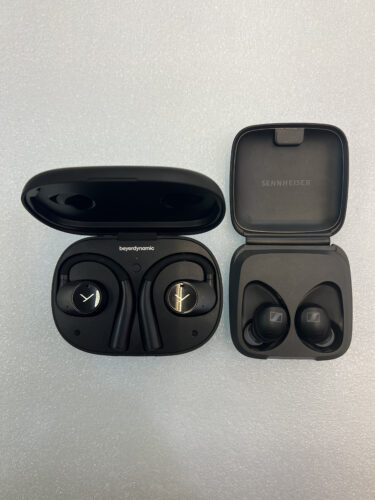
Design
Diving into the design, both earbuds have their strengths. The Sennheiser Momentum Sport features a 10mm transducer, providing a robust sound experience. Although I couldn’t find concrete information on the driver size for the Verio 200, its acoustic design still impresses. The Momentum Sport incorporates an Acoustic Relief channel that minimizes footstep and breathing sounds, creating a more immersive listening experience. In contrast, the Verio 200’s open-design allows me to remain aware of my surroundings, which is crucial for outdoor workouts.
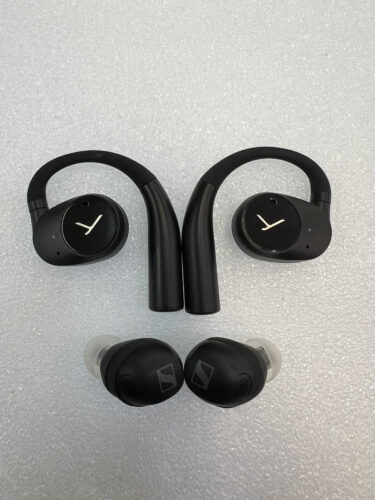
In terms of water resistance, the Momentum Sport boasts an IP55 rating, while the Verio 200 comes in at IP54. Both earbuds perform well in light rain, but the Momentum Sport holds up better against heavier conditions, making them more reliable during intense workouts.
When it comes to Bluetooth connectivity, the Beyerdynamic Verio 200 outshines with Bluetooth® 5.3 support and compatibility with the latest audio codecs, including Qualcomm® aptX™ Adaptive, aptX™ Lossless, and AAC. The Sennheiser Momentum Sport utilizes Bluetooth 5.2 and lacks support for lossless codecs. The Verio 200’s advanced connectivity ensures high-quality audio transmission, which I find valuable, especially while using lossless streamers like Tidal.
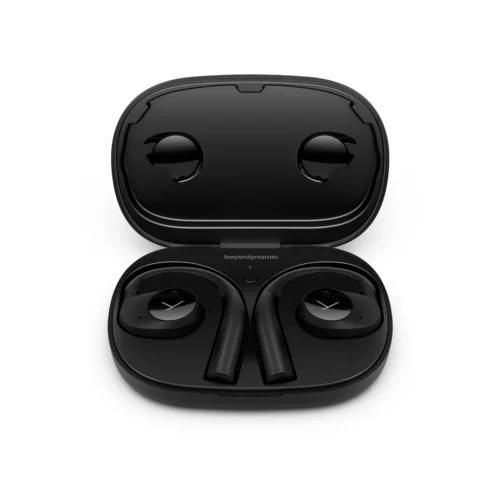
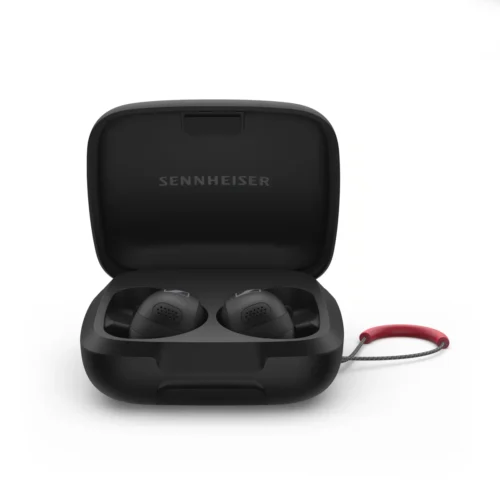
Battery Life
Battery life is another critical factor in my workout earbuds selection. The Momentum Sport offers 6.5 hours of playtime, with an additional 17.5 hours from the charging case. On the other hand, the Verio 200 provides a longer playtime of 8 hours and an impressive 27 hours from the case. However, I noticed that the Beyerdynamic case is bulkier than Sennheiser’s, which feels a bit flimsy. Depending on personal preferences for design and portability, each option has its pros and cons. In terms of battery life, Beyer’s large case proves useful in terms of playtime. The Verio 200 clears the Momentum Sport in terms of battery life.

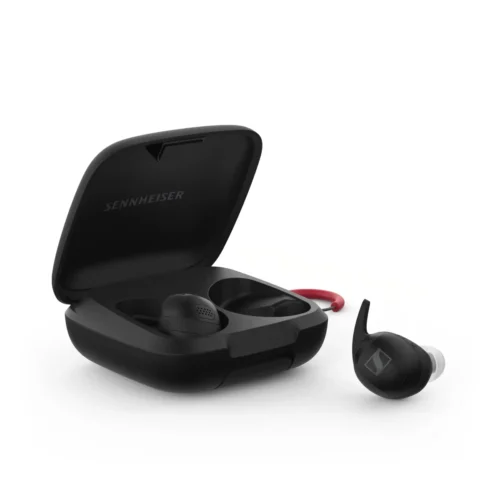
Waterproofing and Workout Performance
Understanding the practical implications of waterproof ratings is crucial for workout earbuds. The IP54 rating of the Verio 200 means it’s protected from limited dust ingress and water spray from any direction. This design works well in light rain and during sweaty workouts. Meanwhile, the Momentum Sport’s IP55 rating provides better protection against dust and low-pressure water jets. I feel confident using these earbuds in more challenging conditions, making them more suited for intense workouts or running in the rain.
Listening Impressions
Soundstage
Now, let’s discuss sound quality, starting with the soundstage. The Verio 200 offers a medium soundstage that feels wider than many in-ear earbuds. However, I found it somewhat lacking in verticality, creating a flat staging. The trailing in sound is supplemented with tuned reverb, which adds some depth. Despite these limitations, I still found the soundstage of the Verio 200 impressive for earbuds.
In contrast, the Momentum Sport benefits from a better seal, leading to stronger clarity in sound imaging. I appreciate the stronger verticality, enhancing my listening experience, especially during workouts. Although both earbuds have similar width in their soundstage, the Momentum Sport edges out in terms of clarity and depth. I will say that during a run or intense lifting session, I’m hardly focused on the panning of a bass guitar, or the verticality of a synth part, but it’s noticeable when concentrating on music.
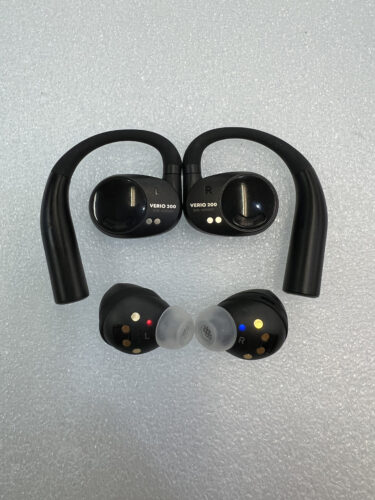
Lows
The low frequencies on both earbuds stand out, but their presentation varies. The Verio 200 emphasizes low-bass and mid-bass, giving it a bass-boosted sound signature reminiscent of audiophile-grade headphones like the Fostex TH808. On the other hand, the Momentum Sport adheres more closely to the Harman curve with added bass, providing a balanced sound with a stronger mid-bass and high-bass presence.
While I enjoy the bass-heavy tuning of the Verio 200, I sometimes find it a bit overwhelming, especially when I want to focus on vocals. The Momentum Sport, while not lacking in low-end, offers a more balanced experience that’s easier on the ears, particularly for those who enjoy vocal-heavy tracks.
Mids
Moving on to the midrange, the Verio 200 impresses with its balanced approach, even with its bass-forward tuning. I found that vocals and synths retain warmth and roundness, creating a full-bodied sound signature. Unlike many bass-heavy headphones that tend to distort midrange frequencies, the Verio 200 strikes a beautiful balance, ensuring clarity and discernibility.
The Momentum Sport also performs admirably in the mids, presenting a more even sound profile. While the volume in the center of the mids is slightly higher, it’s the balance that truly shines. Listening to tracks like “50 Ways to Leave Your Lover” by Paul Simon, I noticed the Verio 200 offered a warmer sound, while the Momentum Sport provided clearer vocal presentation, which I prefer when focusing on lyrics.
Highs
In the high frequencies, the Verio 200 takes a unique approach. While it doesn’t deliver the same analytical sound I expect from Beyerdynamic products, it adds character to the warm sound signature. The treble is understated, designed to complement the bass rather than dominate the mix. This design allows me to remain aware of my surroundings, which is especially useful for outdoor workouts.
Conversely, the Momentum Sport excels in the treble department. It delivers a more balanced sound that competes well with its controlled bass. The Harman-tuned highs provide a warm yet flat sound profile, similar to the Sennheiser house sound. While I appreciate the clarity and balance of the Momentum Sport, I sometimes wished for a bit more detail to create a more exciting sound signature.
Conclusion
In conclusion, both the Sennheiser Momentum Sport and Beyerdynamic Verio 200 offer unique benefits as workout earbuds. If I prioritized immersive sound quality and a snug fit, the Momentum Sport is my top choice. Its superior water resistance, soundstage clarity, and balanced sound signature make it ideal for intense workouts.
However, if I value prolonged battery life and the ability to interact with my environment while enjoying bass-heavy music, the Verio 200 stands out. Its advanced Bluetooth connectivity and thoughtful design cater to those who prefer a wider soundstage and awareness of their surroundings.
Ultimately, the choice between these two TWS earbuds depends on personal preferences. I recommend trying both models to find the perfect fit for your workout routine, ensuring that you enjoy every beat while pushing your limits. For me, I found the Verio 200 to be a better fit due to it’s bass-forward tuning and versatility in both outdoor and indoor workouts.
You Can Get the Verio 200 and Momentum Sport at Audio 46
MAJORHIFI may receive commissions from retail offers.








